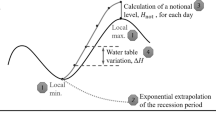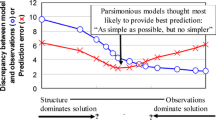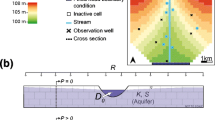Abstract
Specific yield and groundwater recharge of unconfined aquifers are both essential parameters for groundwater modeling and sustainable groundwater development, yet the collection of reliable estimates of these parameters remains challenging. Here, a joint approach combining an aquifer test with application of the water-table fluctuation (WTF) method is presented to estimate these parameters and quantify their uncertainty. The approach requires two wells: an observation well instrumented with a pressure probe for long-term monitoring and a pumping well, located in the vicinity, for the aquifer test. The derivative of observed drawdown levels highlights the necessity to represent delayed drainage from the unsaturated zone when interpreting the aquifer test results. Groundwater recharge is estimated with an event-based WTF method in order to minimize the transient effects of flow dynamics in the unsaturated zone. The uncertainty on groundwater recharge is obtained by the propagation of the uncertainties on specific yield (Bayesian inference) and groundwater recession dynamics (regression analysis) through the WTF equation. A major portion of the uncertainty on groundwater recharge originates from the uncertainty on the specific yield. The approach was applied to a site in Bordeaux (France). Groundwater recharge was estimated to be 335 mm with an associated uncertainty of 86.6 mm at 2σ. By the use of cost-effective instrumentation and parsimonious methods of interpretation, the replication of such a joint approach should be encouraged to provide reliable estimates of specific yield and groundwater recharge over a region of interest. This is necessary to reduce the predictive uncertainty of groundwater management models.
Résumé
Le coefficient d’emmagasinement et la recharge des eaux souterraines d’aquifères captifs sont à la fois des paramètres essentiels pour la modélisation hydrogéologique et l’exploitation durable des eaux souterraines, mais la collecte d’estimations fiables de ces paramètres reste difficile. Ici, une approche conjointe combinant un essai de nappe avec la méthode des variations piézométriques (VP) est présentée pour estimer ces paramètres et quantifier leur incertitude. Cette approche nécessite deux puits: un puits d’observation instrumenté avec une sonde de pression pour un suivi à long terme et un puits de pompage, situé à proximité, pour l’essai de nappe. La dérivée de la courbe des rabattements observés met en évidence la nécessité de représenter un drainage différé, issu de la zone non saturée, lors de l’interprétation des résultats de l’essai de nappe. La recharge des eaux souterraines est estimée avec la méthode VP basée sur des événements, afin de minimiser les effets transitoires de la dynamique des écoulements dans la zone non saturée. L’incertitude de la recharge des eaux souterraines est obtenue à partir de la propagation des incertitudes du coefficient d’emmagasinement (inférence bayésienne) et la dynamique de récession des eaux souterraines (analyze de régression) via l’équation VP. Une part importante de l’incertitude de la recharge des eaux souterraines a pour origine l’incertitude sur le coefficient d’emmagasinement. Cette approche a été appliquée sur un site à Bordeaux (France). La recharge des eaux souterraines a été estimée à 335 mm, avec une incertitude de 86.6 mm à 2σ. En utilisant une instrumentation rentable et des méthodes d’interprétation parcimonieuses, la reproduction de ce type d’approche conjointe devrait être encouragée pour permettre des estimations fiables du coefficient d’emmagasinement et de la recharge des eaux souterraines d’une région d’intérêt. Il est nécessaire de réduire l’incertitude prévisionnelle des modèles de gestion des eaux souterraines.
Resumen
El rendimiento específico y la recarga de acuíferos no confinados son parámetros esenciales para el modelado y el desarrollo sostenible del agua subterránea, sin embargo, la recopilación de estimaciones confiables de estos parámetros sigue siendo un desafío. Aquí, se presenta un enfoque conjunto que combina un ensayo de acuífero con la aplicación del método de fluctuación de la capa freática (WTF) para estimar estos parámetros y cuantificar su incertidumbre. El enfoque requiere dos pozos: uno de observación, bien equipado con una sonda de presión para el monitoreo a largo plazo y un pozo de bombeo, ubicado en las cercanías, para el ensayo del acuífero. La derivada de los niveles de extracción observados destaca la necesidad de representar el drenaje diferido de la zona no saturada al interpretar los resultados del ensayo del acuífero. La recarga de agua subterránea se estima con un método WTF basado en eventos con el fin de minimizar los efectos transitorios de la dinámica de flujo en la zona no saturada. La incertidumbre sobre la recarga de aguas subterráneas se obtiene mediante la propagación de las incertidumbres sobre el rendimiento específico (inferencia bayesiana) y la dinámica de la recesión del agua subterránea (análisis de regresión) a través de la ecuación WTF. Una parte importante de la incertidumbre sobre la recarga del agua subterránea proviene de la incertidumbre sobre el rendimiento específico. El enfoque se aplicó a un sitio en Burdeos (Francia). La recarga de agua subterránea se estimó en 335 mm con una incertidumbre asociada de 86.6 mm a 2σ. Mediante el uso de instrumentación efectiva y métodos parsimoniosos de interpretación, se debe alentar la replicación de dicho enfoque conjunto para proporcionar estimaciones confiables del rendimiento específico y de la recarga del agua subterránea en una región de interés. Esto es necesario para reducir la incertidumbre predictiva de los modelos de gestión del agua subterránea.
摘要
非承压含水层的单位出水量和地下水补给量是地下水模拟和可持续地下水开发中关键的参数,但这些参数的可靠估算值的收集仍然是一个挑战。在这里,介绍了含水层试验结合应用水位波动方法估算这些参数和量化其不确定性的一种联合方法。该方法需要两口井:一口装有用于长期监测的压力探头的观测井和一口位于附近用于含水层试验的抽水井。观测的下降水位强调了在解译含水层试验结果时展示非饱和带延迟的排水的必要性。采用基于事件的WTF 方法估算了地下水补给量,目的就是最小化非饱和带中水流动力学的瞬时影响。通过单位出水量不确定性的扩展(Bayesian推理)以及通过WTF方程进行的地下水回归动力学(回归分析)获取了地下水补给的不确定性。地下水补给的不确定性主要部分源自单位出水量的不确定性。该方法应用在了(法国)Bordeaux的一个试验场地。地下水补给量估算为335 mm,相关不确定性为86.6 mm。通过使用划算的仪器设备和节俭的解译方法,复制使用这种综合方法应当得到鼓励,以便为感兴趣的地区的单位出水量和地下水补给量提供可靠的估算值。这必然会减少地下水管理模型中预测的不确定性。
Resumo
Tanto o rendimento específico como a recarga subterrânea de aquíferos não confinados são parâmetros essenciais para modelagem das águas subterrâneas e para o desenvolvimento sustentável dessas, porém a obtenção de estimativas confiáveis desses parâmetros permanece desafiadora. Nesse estudo, a uma abordagem conjunta combinando um teste de aquífero com a aplicação do método da variação da superfície livre (VSL) é apresentada para estimar esses parâmetros e quantificar suas incertezas. A abordagem requer dois poços: um poço de observação instrumentado com sensor de pressão para monitoramento de longo período e um poço de bombeamento, localizado nas proximidades, para o teste de aquífero. A derivada do nível de rebaixamento observado destaca a necessidade de representar a o tempo de atraso da drenagem a partir da zona não saturada ao interpretar resultados de testes de aquíferos. A recarga subterrânea é estimada a partir de um evento do método VSL a fim de minimizar os efeitos transientes da dinâmica de escoamento na zona não saturada. A incerteza sob a recarga subterrânea é obtida pela propagação das incertezas sob o rendimento específico (inferência Bayesiana) e sob a dinâmica da recessão das águas subterrâneas (análise de recessão) por meio da equação de VSL. A porção majoritária da incerteza sob a recarga subterrânea é originada a partir da incerteza no rendimento específico. A abordagem foi aplicada em um local de Bordeaux (França). A recarga das águas subterrâneas foi estimada em 355 mm com uma incerteza associada de 86.6 mm em 2σ. Por meio do uso de instrumentação tipo custo-eficiência e métodos de parcimônia de interpretação, a reprodução de tal abordagem conjunta deveria ser encorajada para fornecer estimativas confiáveis de rendimento específico e recarga subterrânea em uma região de interesse. Isso é necessário para reduzir a incerteza preditiva de modelos de gerenciamento das águas subterrâneas.







Similar content being viewed by others
References
Acharya S, Jawitz JW, Mylavarapu RS (2012) Analytical expressions for drainable and fillable porosity of phreatic aquifers under vertical fluxes from evapotranspiration and recharge. Water Resour Res 48(11)
Anderson MP, Woessner WW, Hunt RJ (2015) Applied groundwater modeling: simulation of flow and advective transport. Academic, Cambridge, MA
Aster RC, Borchers B, Thurber CH (2013) Parameter estimation and inverse problems. Academic, Cambridge, MA
Barlow PM, Moench AF (2011) WTAQ version 2: a computer program for analysis of aquifer tests in confined and water table aquifers with alternative representations of drainage from the unsaturated zone. US Geol Surv Techniques and Methods 3-B9, 41 pp
Boulton NS (1954) The drawdown of the water table under non-steady conditions near a pumped well in an unconfined formation. Proc Inst Civ Eng 3(4):564–579
Carrera J, Neuman SP (1986) Estimation of aquifer parameters under transient and steady state conditions: 2. uniqueness, stability, and solution algorithms. Water Resour Res 22(2):211–227
Carrera J, Alcolea A, Medina A, Hidalgo J, Slooten LJ (2005) Inverse problem in hydrogeology. Hydrogeol J 13(1):206–222
Cooley RL (1982) Incorporation of prior information on parameters into nonlinear regression ground-water flow models: 1. theory. Water Resour Res 18(4):965–976
Cooper HH, Jacob C (1946) A generalized graphical method for evaluating formation constants and summarizing well-field history. EOS Trans Am Geophys Union 27(4):526–534
Crosbie RS, Binning P, Kalma JD (2005) A time series approach to inferring groundwater recharge using the water table fluctuation method. Water Resour Res 41(1)
Crosbie RS, Davies P, Harrington N, Lamontagne S (2015) Ground truthing groundwater-recharge estimates derived from remotely sensed evapotranspiration: a case in South Australia. Hydrogeol J 23(2):335
Cui T, Ward ND (2012) Uncertainty quantification for stream depletion tests. J Hydrol Eng 18(12):1581–1590
Cuthbert MO (2010) An improved time series approach for estimating groundwater recharge from groundwater level fluctuations. Water Resour Res 46(9)
Cuthbert MO (2014) Straight thinking about groundwater recession. Water Resour Res 50(3):2407–2424
Cuthbert MO, Acworth RI, Andersen MS, Larsen JR, McCallum AM, Rau GC, Tellam JH (2016) Understanding and quantifying focused, indirect groundwater recharge from ephemeral streams using water table fluctuations. Water Resour Res 52(2):857–840
de Marsily G (1986) Quantitative hydrogeology: groundwater hydrology for engineers. Academic, New York
Delottier H, Pryet A, Dupuy A (2017) Why should practitioners be concerned about predictive uncertainty of groundwater management models? Water Resour Manag 31:61–73
Doble R, Crosbie RS (2016) Current and emerging methods for catchment-scale modelling of recharge and evapotranspiration from shallow groundwater. Hydrogeol J 1(25):3–23
Doherty J (2015) Calibration and uncertainty analysis for complex environmental models - PEST: complete theory and what it means for modelling the real world. Watermark, Brisbane, Australia
Fienen MN, Doherty JE, Hunt RJ, Reeves HW (2010) Using prediction uncertainty analysis to design hydrologic monitoring networks: example applications from the Great Lakes Water Availability Pilot Project - Appendix 1. Tech. Rep., US Geological Survey, Reston, VA
Halford KJ, Weight WD, Schreiber RP (2006) Interpretation of transmissivity estimates from single-well pumping aquifer tests. Ground Water 44(3):467–471
Hastings WK (1970) Monte Carlo sampling methods using Markov chains and their applications. Biometrika 57(1):97–109
Healy RW, Cook PG (2002) Using groundwater levels to estimate recharge. Hydrogeol J 10(1):91–109
Healy RW, Scanlon BR (2010) Estimating groundwater recharge, vol 237. Cambridge University Press, Cambridge
Heppner CS, Nimmo JR (2005) A computer program for predicting recharge with a master recession curve. US Geol Surv Sci Invest Rep 2005-5172
Hilberts AGJ, Troch PA, Paniconi C (2005) Storage-dependent drainable porosity for complex hillslopes. Water Resour Res 41(6)
Hill MC, Tiedeman CR (2006) Effective groundwater model calibration: with analysis of data, sensitivities, predictions, and uncertainty. Wiley, Hoboken, NJ
Hughes I, Hase T (2010) Measurements and their uncertainties: a practical guide to modern error analysis. Oxford University Press, Oxford
Hunt RJ, Doherty J, Tonkin MJ (2007) Are models too simple? Arguments for increased parameterization. Ground Water 45(3):254–262
Jeong J, Park E (2017) A shallow water table fluctuation model in response to precipitation with consideration of unsaturated gravitational flow. Water Resour Res 53(4):3505–3512. https://doi.org/10.1002/2016WR020177
King AC, Adam C, Raiber M, Cox ME, Cendon DI (2017) Comparison of groundwater recharge estimation techniques in an alluvial aquifer system with an intermittent/ephemeral stream (Queensland, Australia). Hydrogeol J 25(6):1759–1777
Knowling MJ, Werner AD (2016) Estimability of recharge through groundwater model calibration: insights from a field-scale steady-state example. J Hydrol 540:973–987
Kruseman GP, de Ridder NA (1990) Analysis and evaluation of pumping test data. Pub. 47, ILRI, Wageningen, The Netherlands
Lucas M, Paulo T, Oliveira S, Davi C, Melo D, Wendland E (2015) Evaluation of remotely sensed data for estimating recharge to an outcrop zone of the Guarani aquifer system (South America). Hydrogeol J 23(5):961
Mao D, Wan L, Yeh T-CJ, Lee, Hsu K-C, Wen J-C, Lu W (2011) A revisit of drawdown behavior during pumping in unconfined aquifers. Water Resour Res 47(5)
Mathias S, Butler A (2006) Linearized Richards’ equation approach to pumping test analysis in compressible aquifers. Water Resour Res 42(6)
Meier PM, Carrera J, Sánchez-Vila X (1998) An evaluation of Jacob’s method for the interpretation of pumping tests in heterogeneous formations. Water Resour Res 34(5):1011–1025
Metropolis N, Rosenbluth AW, Rosenbluth MN, Teller AH, Teller E (1953) Equation of state calculations by fast computing machines. J Chem Phys 21(6):1087–1092
Mishra PK, Kuhlman KL (2013) Unconfined aquifer flow theory: from Dupuit to present, chap 9. In: Advances in hydrogeology. Springer, Heidelberg, Germany, pp 185–202
Mishra PK, Neuman SP (2010) Improved forward and inverse analyses of saturated-unsaturated flow toward a well in a compressible unconfined aquifer. Water Resour Res 46(7)
Moench AF (2004) Importance of the vadose zone in analyses of unconfined aquifer tests. Ground Water 42(2):223
Nachabe MH (2002) Analytical expressions for transient specific yield and shallow water table drainage. Water Resour Res 38(10)
Neuman SP (1972) Theory flow in unconfined aquifers considering delayed response of the water table. Water Resour Res 8:1031–1045
Neuman SP, Mishra PK (2012) Comments on “a revisit of drawdown behavior during pumping in unconfined aquifers” by D. Mao, l. Wan, T.-CJ Yeh, C.-H. Lee, K.-C. Hsu, J.-C. Wen, and W. Lu. Water Resour Res 48(2)
Nimmo JR, Horowitz C, Mitchell L (2015) Discrete-storm water table fluctuation method to estimate episodic recharge. Groundwater 53(2):282–292
Nwankwor G, Cherry J, Gillham R (1984) A comparative study of specific yield determinations for a shallow sand aquifer. Ground Water 22(6):764–772
Nwankwor G, Gillham R, Kamp G, Akindunni F (1992) Unsaturated and saturated flow in response to pumping of an unconfined aquifer: field evidence of delayed drainage. Ground Water 30(5):690–700
Ordens CM, Werner AD, Adrian D, Post VEA, Hutson J, Simmons CT, Irvine BM (2012) Groundwater recharge to a sedimentary aquifer in the topographically closed Uley South Basin, South Australia. Hydrogeol J 20(1):61–72
Park E (2012) Delineation of recharge rate from a hybrid water table fluctuation method. Water Resour Res 48(7)
Patil A, Huard D, Fonnesbeck CJ (2010) PyMC: Bayesian stochastic modelling in Python. J Stat Softw 35(4):1
R Core Team (2013). R: a language and environment for statistical computing. R Foundation for Statistical X, Vienna. http://www.R-project.org/
Rasmussen WC, Andreasen GE (1959) Hydrologic budget of the Beaverdam Creek basin, Maryland. US Geol Surv Water Suppl Pap 1472
Rawling G, Newton BT (2016) Quantity and location of groundwater recharge in the Sacramento Mountains, south-central New Mexico (USA), and their relation to the adjacent Roswell Artesian Basin. Hydrogeol J 24(4):757
Renard P (2005) The future of hydraulic tests. Hydrogeol J 13(1):259–262
Renard P, Glenz D, Mejias M (2009) Understanding diagnostic plots for well-test interpretation. Hydrogeol J 17(3):589–600
Rorabaugh MI (1960) Use of water levels in estimating aquifer constants in a finite aquifer. IAHS Publ. 52, IAHS, Wallingford, UK, pp 314–323
Scanlon BR, Healy RW, Cook PG (2002) Choosing appropriate techniques for quantifying groundwater recharge. Hydrogeol J 10(1):18–39
Sophocleous MA (1991) Combining the soilwater balance and water-level fluctuation methods to estimate natural groundwater recharge: practical aspects. J Hydrol 124(3–4):229–241
Tartakovsky GD, Neuman SP (2007) Three-dimensional saturated-unsaturated flow with axial symmetry to a partially penetrating well in a compressible unconfined aquifer. Water Resour Res 43(1)
Theis CV (1935) The relation between the lowering of the piezometric surface and the rate and duration of discharge of a well using ground-water storage. EOS Trans Am Geophys Union 16(2):519–524
Tikhonov A, Arsenin V (1977) Solutions of ill-posed problems. Halsted, New York
Trivedi NM, Kashyap D (2015) Modeling of variably saturated flow in response to pumping from an unconfined aquifer: numerical evidence of gravity-delayed drainage and its parameterization. J Hydrol Eng 21(2):06015,014
van der Spek JE, Bakker M (2017) The influence of the length of the calibration period and observation frequency on predictive uncertainty in time series modeling of groundwater dynamics. Water Resour Res 53(3)
Wu C-M, Yeh T-CJ, Zhu J, Lee TH, Hsu N-S, Chen C-H, Sancho AF (2005) Traditional analysis of aquifer tests: comparing apples to oranges? Water Resour Res 41(9)
Yin L, Hu G, Huang J, Wen D, Dong J, Wang X, Li H (2011) Groundwater-recharge estimation in the Ordos plateau, China: comparison of methods. Hydrogeol J 19(8):1563–1575
Yustres Á, Asensio L, Alonso J, Navarro V (2012) A review of Markov chain Monte Carlo and information theory tools for inverse problems in subsurface flow. Comput Geosci 16(1):1–20
Zhang J, van Heyden J, Bendel D, Barthel R (2011) Combination of soil-water balance models and water table fluctuation methods for evaluation and improvement of groundwater recharge calculations. Hydrogeol J 19(8):1487–1502
Zhou H, Gómez-Hernández JJ, Li L (2014) Inverse methods in hydrogeology: evolution and recent trends. Adv Water Resour 63:22–37
Acknowledgements
The authors are thankful to Professor Julio Goncalves for his relevant comments on the original version of the manuscript. We also thank the associate editor, an anonymous reviewer and Professor Eungyu Park for providing useful comments on the manuscript. The OPURES Climate project and the Aquitaine Region provided funding for the experimental set up.
Author information
Authors and Affiliations
Corresponding author
Rights and permissions
About this article
Cite this article
Delottier, H., Pryet, A., Lemieux, J.M. et al. Estimating groundwater recharge uncertainty from joint application of an aquifer test and the water-table fluctuation method. Hydrogeol J 26, 2495–2505 (2018). https://doi.org/10.1007/s10040-018-1790-6
Received:
Accepted:
Published:
Issue Date:
DOI: https://doi.org/10.1007/s10040-018-1790-6




